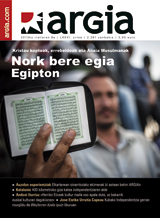The Catalan road to independence
- Following the successful demonstration on September 11, 2012, this year Via Catalana will cross the country from one part to another, becoming a human chain of 400 kilometers in length. Some sectors have asked the Catalan National Assembly to relax the motto of mobilization, which has affirmed that mobilization is plural, but that everyone who participates in it will be "numbered as independentist". As the dates of 2014 approach, political parties are becoming less and less ambiguous.

The Catalan National Assembly (ANC) and the Òmniun Cultural Association have organized a spectacular event for the Day of the Diada. Thousands of people will travel the great human chain that will spread from the Ebro to the Pyrenees, connecting 86 towns and cities of the Principality of Catalonia. There are already 350,000 registered people and almost the entire chain is covered. The so-called “Catalan Route” is inspired by the “Baltic Route” carried out in 1989 in Latvia, Estonia and Lithuania. On that occasion, between almost two million people, they tied the three countries to separate themselves from the USSR; shortly afterwards the Berlin Wall fell.
The ANC aims to achieve the independence of Catalonia since its creation in 2011, and the motto of the human chain coincides with this objective: Via catalana cap a la independència (Catalan way towards independence). On the contrary, the debate was due to the motto, as some politicians from PSC and Unión would prefer a more vague motto referring to the right to self-determination.
According to the ANC President, Carmen Forcadell, this is a debate that is already overtaken. Last year’s Diada brought together over 1.5 million people on the streets of Barcelona, one of Europe’s most massive demonstrations, and the demand for Catalans to have a state of their own spread throughout the world. That demonstration brought the issue of sovereignty to the agenda of the political parties. President Artur Mas advanced the elections and supporters of the right to decide won easily. CIU and ERC agreed to hold a referendum on self-determination in 2014.
With this year’s act, the organisers want to go further, to make the referendum irreversible, as a last step towards independence. The ANC decided at its last general assembly that the referendum should be scheduled for 31 May 2014, and in this regard, Forcadell has asked Mas to set the date and question for the consultation the following day of the Diada.
Self-determination, independence and cutbacks
Over time, the distance to ambiguity is narrowing, and the controversy emerging from the motto of the human chain has shown only the nervousness of some. It will have to be seen whether the most conservative politicians in Union come together – Duran i Lleida was presented at the last moment to the demonstration last year – and how the Catalanists of the CSP respond. The position of the socialist leadership is contrary to the human chain, but in recent months hundreds of militants have left the party for criticizing the official line.
On the other hand, in the political organisation of the CUP, which unequivocally defends independence, there are many views, the question of territoriality – the ANC aims at the independence of the four territories of the Principat, leaving the rest of the Catalan countries – and the risks of the social struggle being relegated. In this context, although the Cup has called to participate in the Catalan Way, in the parallel chains opened by leftist movements there will also be leftist independentists, such as the La Caixa building or the Josep Trueta hospital in Girona.
Catalans have suffered severe cuts in health and social services in recent years; according to a recent study, in Catalonia 50,000 children do not eat enough. On the other hand, the CIU Government, with the assistance of ERC, will extend the budgets considering that the deficit target set by the Spanish Government is too low (1.58%). After last year’s elections, ERC had to choose from the following options: Support CIU cutbacks or jeopardise the roadmap to independence. He opted for the first, so as not to lose the independence wave, and it seems that the wager will not go wrong, according to some surveys the seats would double and it would become the first force in Parliament.
The party of Artur Mas, Convergència Democràtica de Catalunya, is already engaged in the task of warming the act, but the president will not participate in the human chain of CDC. However, it will receive a delegation from the ANC and the Executive Committee of the Generalitat will authorize members and officials to participate personally in the human chain, as it has “positively” valued the initiative. It seems that, after last year’s demonstration, politicians have realised that in Catalonia an internal engine has been launched, that it is civil society that makes up the machinery and that in vain they will try to change the GPS coordinates or slow down the speed. The last barometer of the Generalitat indicates that 55% of Catalans would vote for independence in a hypothetical referendum, a percentage that has risen 15 points in two years.
Heating motors
The ANC has about 30,000 members, thrown by numerous social agents and people of reference for Catalan society. The organization is organized by counties and sectors, and in each campaign it does an extraordinary job. Many of the members of the ANC are CDC and ERC cadres, but it also brings many people together beyond the political realm and that is their main strength.
The human chain has been divided into parts to cover the entire capacity of the Catalan Way, the organization has reported. It is the groups of the region and of each people who are responsible for dynamizing their part. More than 80% of the human chain is already formed, as these are the large extensions of the Ebro and La Jonquera, which are not yet entirely safe. The ANC has called on the citizens to join these areas of the city as well.
As 11 September approaches, there is a growing number of acts calling for mobilisation. Human chains have been carried out around the world: In Tokyo, Edinburgh, Sao Paulo, Los Angeles… In total they have been organized in 90 cities. In Euskal Herria, the Independentistak network has also organized human chains in the capitals on day 7 and in Bilbao on the afternoon of September 11, the Catalan community of the area is another human chain, according to social networks. On Twitter, through the hashtags #viacatalana and #femvia (let's make the way) users are constantly being informed and giving their opinion. On the other hand, an initiative has been launched on 8 September to collect the star in the 400 mountains of Catalonia.
And then?
No one doubts the success of the Catalan Way and that, as was already the case with the manifestation of the Diada last year, it will be an unprecedented display of strength of Catalan independence. The media around the world will receive images and news from the human chain; the organizers have rented 20 avionettes to record the mobilization in its entirety.
Artur Mas will take advantage of the act to follow the path so far and claim that Catalonia is a nation and that Spain is a nation. But what further? In January 2013, the Catalan Parliament approved a declaration of sovereignty, which was suspended by the Spanish courts. On the other hand, the Generalitat is taking numerous steps to “endow the country with state structures”. It has thus created Catalan finance, opened numerous international delegations, launched the Christmas lottery and set up a commission to analyse the different scenarios created after the referendum of self-determination.
In July, Mas sent a letter to the president of the Spanish Government, Mariano Rajoy, asking him to agree to the 2014 consultation, which would reply to him at the end of the summer. The Govern ment is therefore awaiting the response of Spain and, depending on that response, will take the next steps.
Before the referendum, many hypotheses have been put forward as to what Spain is going to do: the suspension of self-government is one of the options, some unionist and military extremists have suggested armed intervention, and there are those who have equated the situation with the Balkans. The writer and professor Héctor López Bofill has written in El Punt Avui the article Think the pitjor (worse think) and says that when Aznar announced in 2005 the “Balcanization of Spain”, he did not say empty words: “The contradiction between popular will and the tax regime will lead Spain to use violence, convinced that the danger of repeated murders that have happened throughout history will end the Catalan middle class.”
1989ko abuztuaren 23an, ehunka mila lagun Letonia, Lituania eta Estoniako errepide eta kaleetara irten ziren aldarrikapen sendo batekin: elkartasunean estatu independenteak izatea. Egun horretan 50 urte bete ziren sobietarrek naziekin akordioa sinatu zutela elkarren kontra ez egiteko; ondorioz SESBek Baltikoko hiru herrialdeak anexionatzeko ateak irekita geratu ziren, hortik urtebetera gertatu zen hori, 1940an, Bigarren Mundu Gerra hasi eta berehala.
50 urte geroago egoera oso bestelakoa zen. Perestroikaren ostean, Sobietar Batasuna desegiten ari zen zantzu garbiak zeuden eta herritarren protestak gero eta agerikoagoak ziren. Testuinguru horretan, Baltikoko herrialdeetako jendeek urteurren hura baliatu zuten ekimen ikusgarri bat burutzeko: errepublika horietako hiru hiriburuak (Tallin, Riga eta Vilnius) lotuko zituen giza kate erraldoia antolatu zuten, 600 kilometro baino gehiagokoa.
2013an katalanek egin moduan, Bide Baltikoan hutsunerik ez egoteko, katea zati ugaritan banatu zuten, autobusak antolatu zituzten leku urrunenetara, irratiz ere koordinatu zuten ekimena… Arratsaldeko 16:00etan elkarri eskuak eman eta inoiz egin den giza kate handiena osatu zuten 15 minutuz. Zenbait kalkuluren arabera 1,5 eta 2 milioi lagun artean bildu ziren giza katean. Hilabete batzuk geroago Berlingo harresia erori zen eta hortik gutxira Baltikoko errepublikek euren independentzia aldarrikatu zuten.
Egun, Lituanian, Estonian eta Letonian harrotasun osoz gogoratzen dute 1989ko ekimen hura, hainbat oroitarri jaso dituzte horretarako eta gertaera mugarritzat hartu izan da euren historian.
Walk from a train station, two friends and a hug. This hug will be frozen until the next meeting. I'll come home, he'll stay there. There, too, will be free the painful feeling that injustice wants us to catch. Jesús Rodríguez (Santa Coloma de Gramenet, 1974) is a journalist,... [+]

























